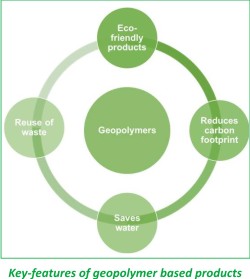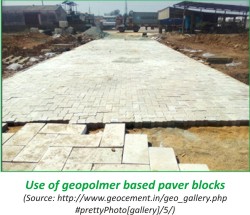|
Geopolymers: An Approach
towards
Building
materials are always in demand in the construction sector, especially in
developing countries. To reduce our dependency on virgin materials,
researchers are developing resource efficient building materials. Geopolymer is one such emerging approach towards green building
materials. Geopolymer is an amorphous, 3-D inorganic polymer formed when
a highly concentrated aqueous alkali hydroxide-silicate solution is
added to an alumino
Kiran Global Chems Ltd., a Chennai based
company adopted the geopolymer technology developed by Professor J Davidovits. Kiran Global Chems, started in 1979 as a chemical
manufacturing company. It currently produces geocement, geopolymer
activator, geopolymer powder, geopolymer concrete and geopolymer
concrete blocks. The company believes in environmental protection, a
sustainable future and a green building concept. Their most recent
initiative is to utilise waste for manufacturing green cement called
geocement. Th Way Forward With the amount of industrial wastes including boiler ash, slag, fly ash, pond ash and construction and demolition (C&D) waste generated in India, the sector needs a push to adapt technologies and practices focused on ‘waste to wealth’. Kiran Global Chems. is an initiative in this direction and many such replications in the country are needed to reduce our dependency on virgin materials.
References: • Bagci, C., Kutyla, GP., Kriven, WM (2017) Fully reacted high strength geopolymer made with diatomite as a fumed silica alternative, Ceramics International, 43, 14784-14790 • Davidovits, J., 2011. Geopolymer Chemistry and Applications, third ed. Institut Geopolymere, Saint-Quentin, France. • Singh, B., Ishwarya, G., Gupta, M., Bhattacharyya, SK. (2015) Geopolymer concrete: a review of some recent developments, Construction and Building Materials, 85, 78-90 • Sudhakar, MR and Indra Prasad Acharya, IP. (2014) Synthesis and Characterization of Fly Ash Geopolymer Sand. Journal of Materials in Civil Engineering, 26, 5. ■
Dr. Ankur Sarswat
|
 silicate raw material such as slag, fly ash, calcined
clay etc. (Davidovits, 2011). Being energy efficient and eco-friendly,
geopolymers are gaining attention. During production, geopolymers
release 80% less CO2 than Portland cement. They exhibit
attractive characteristics including high compressive strength, low
shrinkage, fast setting, acid and fire resistance, low thermal conductivity etc (Bagci
et al., 2017). Some recent examples on geopolymers include manufacturing
artificial sand by geopolymerising fly ash, diatomite based geopolymers
etc (Bagci et al., 2017). The material thus obtained is highly stable,
chemical resistant, hard and adheres to different surfaces (Singh,
2015). Geopolymers are alternative binders to Portland cement (OPC)
while producing mortars and concrete (Sudhakar, 2014). Replacing OPC
with geopolymers favours low energy consumption and more carbon savings
(Sudhakar, 2014).
silicate raw material such as slag, fly ash, calcined
clay etc. (Davidovits, 2011). Being energy efficient and eco-friendly,
geopolymers are gaining attention. During production, geopolymers
release 80% less CO2 than Portland cement. They exhibit
attractive characteristics including high compressive strength, low
shrinkage, fast setting, acid and fire resistance, low thermal conductivity etc (Bagci
et al., 2017). Some recent examples on geopolymers include manufacturing
artificial sand by geopolymerising fly ash, diatomite based geopolymers
etc (Bagci et al., 2017). The material thus obtained is highly stable,
chemical resistant, hard and adheres to different surfaces (Singh,
2015). Geopolymers are alternative binders to Portland cement (OPC)
while producing mortars and concrete (Sudhakar, 2014). Replacing OPC
with geopolymers favours low energy consumption and more carbon savings
(Sudhakar, 2014).  is geocement is blended with bye-product materials such as
fly ash, rice husk ash, slag, activated clay, alumina to form a concrete
for quick setting (150 minutes). This type of producs can be very useful
in repairing of flyovers or roads that carry heavy traffic load and
cannot be blocked for several hours. The company demonstrated use of
geopolymers based paver blocks for a pathway.
is geocement is blended with bye-product materials such as
fly ash, rice husk ash, slag, activated clay, alumina to form a concrete
for quick setting (150 minutes). This type of producs can be very useful
in repairing of flyovers or roads that carry heavy traffic load and
cannot be blocked for several hours. The company demonstrated use of
geopolymers based paver blocks for a pathway.